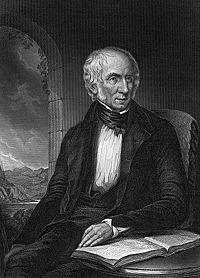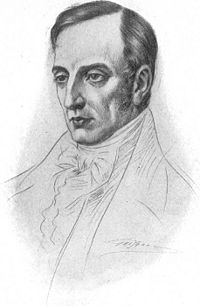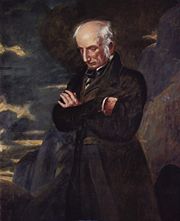William Wordsworth
| William Wordsworth | |
|---|---|
 |
|
| Born | 7 April 1770. Cockermouth, England, UK |
| Died | 23 April 1850 (aged 80) Ambleside, England, UK |
| Occupation | Poet |
| Literary movement | Romanticism |
|
Influences
|
|
|
Influenced
|
|
William Wordsworth (7 April 1770 – 23 April 1850) was a major English Romantic poet who, with Samuel Taylor Coleridge, helped launch the Romantic Age in English literature with their 1798 joint publication, Lyrical Ballads.
Wordsworth's magnum opus is generally considered to be The Prelude, a semi autobiographical poem of his early years which the poet revised and expanded a number of times. The work was posthumously titled and published, prior to which it was generally known as the poem "to Coleridge". Wordsworth was England's Poet Laureate from 1843 until his death in 1850.
Contents |
Biography
Early life and education
The second of five children born to John Wordsworth and Ann Cookson, William Wordsworth was born on 7 April 1770 in Cockermouth in Cumberland — part of the scenic region in north-west England, the Lake District. His sister, the poet and diarist Dorothy Wordsworth, to whom he was close all his life, was born the following year, and the two were baptised together. They had three other siblings: Richard, the eldest who became a lawyer; John, born after Dorothy, who would become a poet and enjoy nature with William and Dorothy until he died in a 1805 shipwreck; and Christopher, the youngest, who would become a scholar. Their father was a legal representative for James Lowther, 1st Earl of Lonsdale and through his connections they were able to live in a large mansion in the small town. Wordsworth, as with his siblings, had little involvement with their father, and they would be distant with him until his death in 1783.[1]
Wordsworth's father, although rarely present, did teach him poetry, including that of Milton, Shakespeare, and Spenser, in addition to allowing his son to rely on his father's library. In addition to spending his time reading in Cockermouth, he would stay at his mother's parents home in Penrith, Cumberland. At Penrith, Wordsworth was exposed to the moors and was influenced by his experience with the landscape and was further turned towards nature by the harsh treatment he received at the hands of his relatives. In particular, Wordsworth could not get along with his grand parents and his uncle, and his hostile interactions with them distressed him to the point of contemplating suicide.[2]
After the death of their mother in 1778, their father sent William to Hawkshead Grammar School and sent Dorothy to live with relatives in Yorkshire. She and William did not meet again for another nine years. Although Hawkshead was Wordsworth's first serious experience with education, he was taught to read by his mother and attended a tiny school in Cockermouth of low quality. After the Cockermouth school, he was sent to a school in Penrith for the children of upper class families and taught by Ann Birkett, a woman who insisted in instilling tradition in her students that included pursuing both scholarly and local activities, especially the festivals around Easter, May Day, or Shrove Tide. Wordsworth was taught both the Bible and the Spectator, but little else. It was at the school that Wordsworth was to meet the Hutchinsons, including Mary, who would be his future wife.[3]
Wordsworth made his debut as a writer in 1787 when he published a sonnet in The European Magazine. That same year he began attending St John's College, Cambridge, and received his B.A. degree in 1791.[4] He returned to Hawkshead for his first two summer holidays, and often spent later holidays on walking tours, visiting places famous for the beauty of their landscape. In 1790, he took a walking tour of Europe, during which he toured the Alps extensively, and also visited nearby areas of France, Switzerland, and Italy. His youngest brother, Christopher, rose to be Master of Trinity College.[5]
Relationship with Annette Vallon
In November 1791, Wordsworth visited Revolutionary France and became enthralled with the Republican movement. He fell in love with a French woman, Annette Vallon, who in 1792 gave birth to their child, Caroline. Because of lack of money and Britain's tensions with France, he returned alone to England the next year.[6] The circumstances of his return and his subsequent behaviour raise doubts as to his declared wish to marry Annette but he supported her and his daughter the best he could in later life. During this period, he wrote his acclaimed "It is a beauteous evening, calm and free," recalling his seaside walk with his wife, whom he had not seen for ten years. At the conception of this poem, he had never seen his daughter before. The occurring lines reveal his deep love for both child and mother. The Reign of Terror estranged him from the Republican movement, and war between France and Britain prevented him from seeing Annette and Caroline again for several years. There are also strong suggestions that Wordsworth may have been depressed and emotionally unsettled in the mid 1790s.
With the Peace of Amiens again allowing travel to France, in 1802 Wordsworth and his sister, Dorothy visited Annette and Caroline in France and arrived at a mutually agreeable settlement regarding Wordsworth's obligations.[6]
First publication and Lyrical Ballads
In his "Preface to Lyrical Ballads" which is called the 'manifesto' of English Romantic criticism, Wordsworth calls his poems ' experimental'. 1793 saw Wordsworth's first published poetry with the collections An Evening Walk and Descriptive Sketches. He received a legacy of £900 from Raisley Calvert in 1795 so that he could pursue writing poetry. That year, he also met Samuel Taylor Coleridge in Somerset. The two poets quickly developed a close friendship. In 1797, Wordsworth and his sister, Dorothy, moved to Alfoxton House, Somerset, just a few miles away from Coleridge's home in Nether Stowey. Together, Wordsworth and Coleridge (with insights from Dorothy) produced Lyrical Ballads (1798), an important work in the English Romantic movement. The volume had neither the name of Wordsworth nor Coleridge as the author. One of Wordsworth's most famous poems, "Tintern Abbey", was published in the work, along with Coleridge's "The Rime of the Ancient Mariner". The second edition, published in 1800, had only Wordsworth listed as the author, and included a preface to the poems, which was significantly augmented in the 1802 edition. This Preface to Lyrical Ballads is considered a central work of Romantic literary theory. In it, Wordsworth discusses what he sees as the elements of a new type of poetry, one based on the "real language of men" and which avoids the poetic diction of much eighteenth-century poetry. Here, Wordsworth also gives his famous definition of poetry as the "the spontaneous overflow of powerful feelings from emotions recollected in tranquility." A fourth and final edition of Lyrical Ballads was published in 1805.
Germany and move to the Lake District
Wordsworth, Dorothy, and Coleridge then travelled to Germany in the autumn of 1798. While Coleridge was intellectually stimulated by the trip, its main effect on Wordsworth was to produce homesickness.[6] During the harsh winter of 1798–1799, Wordsworth lived with Dorothy in Goslar, and despite extreme stress and loneliness, he began work on an autobiographical piece later titled The Prelude. He also wrote a number of famous poems, including "The Lucy poems". He and his sister moved back to England, now to Dove Cottage in Grasmere in the Lake District, and this time with fellow poet Robert Southey nearby. Wordsworth, Coleridge, and Southey came to be known as the "Lake Poets".[7] Through this period, many of his poems revolve around themes of death, endurance, separation, and grief.


Marriage and Children
In 1802, after returning from his trip to France with Dorothy to visit Annette and Caroline, Lowther's heir, William Lowther, 1st Earl of Lonsdale, repaid the ₤4,000 debt's owed to Wordsworth's father incurred through Lowther's failure to pay his aide.[8] Later that year, Wordsworth married a childhood friend, Mary Hutchinson.[6] Dorothy continued to live with the couple and grew close to Mary. The following year, Mary gave birth to the first of five children:
- John Wordsworth (June 18 1803 - 1875). Married four times:
- 1.) Isabella Curwen (d. 1848) had six children: Jane, Henry, William, John, Charles and Edward.
- 2.) Helen Ross (d. 1854). No issue.
- 3.) Mary Ann Dolan (d. after 1856) had 1 daughter Dora (b.1858).
- 4.) Mary Gamble. No issue.
- Dora Wordsworth (August 16 1804 - July 9th 1847). Married Edward Quillinan
- Thomas Wordsworth (June 15 1806 - December 1st 1812).
- Catherine Wordsworth (September 6 1808 - June 4th 1812).
- William "Willy" Wordsworth (May 12 1810 - 1883). Married Fanny Graham and had four children: Mary Louisa, William, Reginald and Gordon.
Autobiographical work and Poems in Two Volumes
Wordsworth had for years been making plans to write a long philosophical poem in three parts, which he intended to call The Recluse. He had in 1798–99 started an autobiographical poem, which he never named but called the "poem to Coleridge", which would serve as an appendix to The Recluse. In 1804 he began expanding this autobiographical work, having decided to make it a prologue rather than an appendix to the larger work he planned. By 1805, he had completed it, but refused to publish such a personal work until he had completed the whole of The Recluse. The death of his brother, John, in 1805 affected him strongly.
The source of Wordsworth's philosophical allegiances as articulated in The Prelude and in such shorter works as "Lines composed a few miles above Tintern Abbey" has been the source of much critical debate. While it had long been supposed that Wordsworth relied chiefly on Coleridge for philosophical guidance, more recent scholarship has suggested that Wordsworth's ideas may have been formed years before he and Coleridge became friends in the mid 1790s. While in Revolutionary Paris in 1792, the twenty-two year old Wordsworth made the acquaintance of the mysterious traveller John "Walking" Stewart (1747-1822),[9] who was nearing the end of a thirty-years' peregrination from Madras, India, through Persia and Arabia, across Africa and all of Europe, and up through the fledgling United States. By the time of their association, Stewart had published an ambitious work of original materialist philosophy entitled The Apocalypse of Nature (London, 1791), to which many of Wordsworth's philosophical sentiments are likely indebted.
In 1807, his Poems in Two Volumes were published, including "Ode: Intimations of Immortality from Recollections of Early Childhood". Up to this point Wordsworth was known publicly only for Lyrical Ballads, and he hoped this collection would cement his reputation. Its reception was lukewarm, however. For a time (starting in 1810), Wordsworth and Coleridge were estranged over the latter's opium addiction.[6] Two of his children, Thomas and Catherine, died in 1812. The following year, he received an appointment as Distributor of Stamps for Westmorland, and the £400 per year income from the post made him financially secure. His family, including Dorothy, moved to Rydal Mount, Ambleside (between Grasmere and Rydal Water) in 1813, where he spent the rest of his life.[6]
The Prospectus
In 1814 he published The Excursion as the second part of the three-part The Recluse. He had not completed the first and third parts, and never would complete them. However, he did write a poetic Prospectus to "The Recluse" in which he lays out the structure and intent of the poem. The Prospectus contains some of Wordsworth's most famous lines on the relation between the human mind and nature:
- My voice proclaims
- How exquisitely the individual Mind
- (And the progressive powers perhaps no less
- Of the whole species) to the external World
- Is fitted:--and how exquisitely, too,
- Theme this but little heard of among Men,
- The external World is fitted to the Mind . . .
Some modern critics recognise a decline in his works beginning around the mid-1810s. But this decline was perhaps more a change in his lifestyle and beliefs, since most of the issues that characterise his early poetry (loss, death, endurance, separation, abandonment) were resolved in his writings. But, by 1820 he enjoyed the success accompanying a reversal in the contemporary critical opinion of his earlier works. Following the death of his friend the painter William Green in 1823, Wordsworth mended relations with Coleridge.[10] The two were fully reconciled by 1828, when they toured the Rhineland together.[6] Dorothy suffered from a severe illness in 1829 that rendered her an invalid for the remainder of her life. In 1835, Wordsworth gave Annette and Caroline the money they needed for support.
The Poet Laureate and other honours
Wordsworth received an honorary Doctor of Civil Law degree in 1838 from Durham University, and the same honour from Oxford University the next year.[6] In 1842 the government awarded him a civil list pension amounting to £300 a year. With the death in 1843 of Robert Southey, Wordsworth became the Poet Laureate. When his daughter, Dora, died in 1847, his production of poetry came to a standstill.
Death
William Wordsworth died of pneumonia on the 23rd April 1850 and was buried at St. Oswald's church in Grasmere. His widow Mary published his lengthy autobiographical "poem to Coleridge" as The Prelude several months after his death. Though this failed to arouse great interest in 1850, it has since come to be recognised as his masterpiece.
Major works
- Lyrical Ballads, with a Few Other Poems (1798)
- "Simon Lee"
- "We Are Seven"
- "Lines Written in Early Spring"
- "Expostulation and Reply"
- "The Tables Turned"
- "The Thorn"
- "Lines Composed A Few Miles above Tintern Abbey"
- Lyrical Ballads, with Other Poems (1800)
- Poems, in Two Volumes (1807)
- "Resolution and Independence"
- "I Wandered Lonely as a Cloud" Also known as "Daffodils"
- "My Heart Leaps Up"
- "Ode: Intimations of Immortality"
- "Ode to Duty"
- "The Solitary Reaper"
- "Elegiac Stanzas"
- "Composed upon Westminster Bridge, September 3, 1802"
- "London, 1802"
- "The world is too much with us"
- The Excursion (1814)
- "Prospectus to The Recluse"
- Ecclesiastical Sketches (1822)
- "Mutability"
- The Prelude (1850, posthumous)
- The Prelude; or, Growth of a Poet's Mind
Notes
- ↑ Moorman 1968 pp. 5-7
- ↑ Moorman 1968 pp. 9-13
- ↑ Moorman 1968 pp. 15-18
- ↑ "William Wordsworth, Biography and Works". The Literature Network. Retrieved on 2008-08-10.
- ↑ Appendix A (Past Governors) of Allport, D.H. & Friskney, N.J. "A Short History of Wilson's School", Wilson's School Charitable Trust, 1986
- ↑ 6.0 6.1 6.2 6.3 6.4 6.5 6.6 6.7 [1]Everett, Glenn, "William Wordsworth: Biography" Web page at The Victorian Web Web site, accessed 7 January 2007
- ↑ See: Recollections of the Lake Poets.
- ↑ Moorman 1968 p. 8
- ↑ Kelly Grovier, "Dream Walker: A Wordsworth Mystery Solved", Times Literary Supplement, 16 February 2007
- ↑ Gentlemans Magazine|Sylvanus Urban- 1823
- ↑ 11.0 11.1 11.2 11.3 11.4 M. H. Abrams, editor of The Norton Anthology of English Literature: The Romantic Period, writes of these five poems: "This and the four following pieces are often grouped by editors as the 'Lucy poems,' even though 'A slumber did my spirit seal' does not identify the 'she' who is the subject of that poem. All but the last were written in 1799, while Wordsworth and his sister were in Germany, and homesick. There has been diligent speculation about the identity of Lucy, but it remains speculation. The one certainty is that she is not the girl of Wordsworth's 'Lucy Gray'" (Abrams 2000).
References
- Moorman, Mary. William Wordsworth: A Biography, The Early Years 1770-1803. Oxford: Oxford University Press, 1968.
- M. H. Abrams, ed. (2000), The Norton Anthology of English Literatures: Volume 2A, The Romantic Period (7th ed.), New York: W. W. Norton & Company, Inc., ISBN 0-393-97568-1
- Stephen Gill, ed. (2000), William Wordsworth: The Major Works, New York: Oxford University Press, Inc., ISBN 0-19-284044-4
External links
General information and biographical sketches
- "Wordsworth's hidden arguments": an article in the TLS by Dan Jacobson, October 31 2007
- Mallaby, George, Wordsworth: a Tribute (1950)
- Short biographical sketch by Glenn Everett
- Worsworth's links with Claines, Worcester
- Wordsworth and the Lake District
- Wordsworth's Grave
- Biography and Works
- Wordsworth and the Lake District
- The Wordsworth Trust
- Romantic Circles: Editions & articles on Wordsworth and other authors of the Romantic period
- Hawkshead Grammar School Museum
Wordsworth's works
- Works by William Wordsworth at Bartleby.com (HTML)
- Works by William Wordsworth at Internet Archive (scanned books original editions color illustrated)
- Works by William Wordsworth at Project Gutenberg (plain text and HTML)
- Poems by William Wordsworth
- Selected Poems by W.Wordsworth
- Selected Works at Poetry Index
- Biography and Works
- Poetry Archive: 166 poems of William Wordsworth
- To Toussaint Louverture - poem by William Wordsworth
- Extensive Information on Wordsworth's Poem, Lines Written a Few Miles above Tintern Abbey
| Preceded by Robert Southey |
British Poet Laureate 1843–1850 |
Succeeded by Alfred Tennyson |
|
||||||||||||||||||||
| Persondata | |
|---|---|
| NAME | Wordsworth, William |
| ALTERNATIVE NAMES | |
| SHORT DESCRIPTION | English poet |
| DATE OF BIRTH | 7 April 1770 |
| PLACE OF BIRTH | Cockermouth, England |
| DATE OF DEATH | 23 April 1850 |
| PLACE OF DEATH | Ambleside, England |